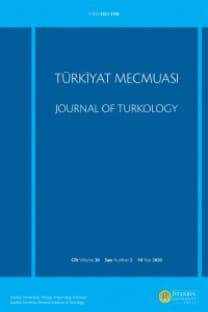31 MART İSYANI'NIN TRABZON'DAKİ YANKILARI
Özet Bu çalışma; 13 Nisan 1909 (31 Mart 1325-Rumî) tarihinde İstanbul'da Meşrutiyet ve İttihat ve Terakki Cemiyeti'nin yönetimine karşı başlatılan isyanın Trabzon'daki yankılarını ortaya koymayı amaçlamaktadır. Bu nedenle, öncelikle Sultan II. Abdülhamit'in saltanatı süresince yaşanan olaylar ve bu dönemde illegal bir şekilde muhalefet yapmaya çalışan İttihat ve Terakki Cemiyeti'nin faaliyetleri, II. Meşrutiyet döneminde yaşanan gelişmeler ve 31 Mart İsyanı sırasında yaşananlar kısaca ele alındıktan sonra 31 Mart İsyanı'nın Trabzon'daki yankıları aktarılmaya çalışılmıştır. Bu bağlamda; isyan haberinin Trabzon'a ulaşmasının ardından, şehirdeki İttihat ve Terakki Cemiyeti'nin yerel temsilcileri tarafından yapılan Meşrutiyet lehinde ve isyancıların aleyhindeki propagandalar ve bunların neticesinde organize edilen protesto gösterilerinin Trabzon'un siyasi ve toplumsal havasına etkileri ayrıntılarıyla aktarılmaya çalışılmıştır. Meşrutiyet ve İttihat ve Terakki Cemiyeti lehindeki bu gösteriler sırasında herhangi bir olumsuzluğa meydan vermemek için Trabzon'daki mülki erkânın ve şehirdeki İngiliz Konsolosu'nun çalışmaları da anlatılmıştır. Sultan II. Abdülhamit'in tahttan indirilmesinin Trabzon'da doğurduğu etkilerin ifade edilmesinin ardından, İstanbul'daki isyana katıldıktan sonra bir şekilde kaçarak Trabzon ve civarına ulaşan firari isyancıların yakalanıp Divan-ı Harp'te yargılanmak üzere İstanbul'a gönderilmelerinden bahsedilmiştir. Osmanlı Devleti'nin önemli stratejik noktalarından biri olan Trabzon'da yaşanan bu gelişmeler, şehirdeki İngiliz Konsolosu'nun kaleme almış olduğu raporlardan, gazete haberlerinden, hatıratlardan ve Osmanlı arşiv belgelerinden takip edilmeye ve edinilen bilgiler ayrıntılı bir şekilde incelenerek değerlendirilmeye çalışılmıştır. Modern Türk tarihinde önemli etkileri olan 31 Mart İsyanı'nın Trabzon gibi önemli bir şehirdeki yankıları ayrıntılarıyla ele alınmıştır. Anahtar Kelimeler: Trabzon, 31 Mart İsyanı, II. Meşrutiyet, İttihat ve Terakki Cemiyeti THE REFLECTIONS OF 31st MARCH INCIDENT IN TRABZON Abstract This paper aims to put out the reflections of the revolt that occurred in Istanbul against the Constitutional regime and the administration of the Committee of Union and Progress (CUP) on 13th April 1909 (31st March 1325 in Rumi calendar) in Trabzon. Therefore, this study is going to describe the political events that occurred during the reign of Sultan Abdulhamit II, the illegal activities of the CUP against the Hamidian regime, the events at the Second Constitutional period and the events during the 31st March Incident and then the reflections of the 31st March Incident in Trabzon are going to be explained. The social and political influences of the protests, organized by the local representatives of the CUP in favor of the Constitution and against the rebels are going to be expressed. Also, the efforts of the local officers and the British consul for preventing any negative activities during the demonstrations in favor of the Constitution are going to be held in this work. After mentioning the effects of the dethronement of Sultan Abdulhamit II in Trabzon, capturing the escapee rebels in Trabzon and sending them back to Istanbul for judgments in the Martial Court is going to be explained. These events in Trabzon – a strategic city in Ottoman era- are tried to be followed throughout the reports of the British consul in the city, the newspaper clippings, the memoirs and the Ottoman archival documents and the information that held from these sources is going to be evaluated in detail. The reflections of the 31st March Incident, which has a significant role in modern Turkish history, in Trabzon are going to be mentioned in this paper. Key Words: Trabzon, the 31st March Incident, the Second Constitution, the Committee of Union and Progress.
Anahtar Kelimeler:
Trabzon, 31 Mart İsyanı, II. Meşrutiyet, İttihat ve
- Başlangıç: 1925
- Yayıncı: İstanbul Üniversitesi Türkiyat Araştırmaları Enstitüsü
Sayıdaki Diğer Makaleler
Mübahat S. Kütükoğlu, XVI. Asırda Çeşme Kazasının Sosyal ve İktisadî Yapısı, Ankara 2010, 309 S.
TÜRKÇE TE'LÎF EDİLMİŞ BİR BELÂGAT KİTABI: ŞERÎFÎ'NİN HADÎKATÜ'L-FÜNÛN İSİMLİ ESERİ
SAFEVÎ DEVLETİ'NİN GÜÇLÜ MELİKESİ HAYRÜNNİSA BEGÜM (985-987/1578-1579)
ÇİN TATARCASI’NDA YAPIM EKLERİ
Ali Şükrü ÇORUK, Osmanlı Sarayında Gündelik Hayat, Kitabevi Yayınları, İstanbul 2011, 573 S.
